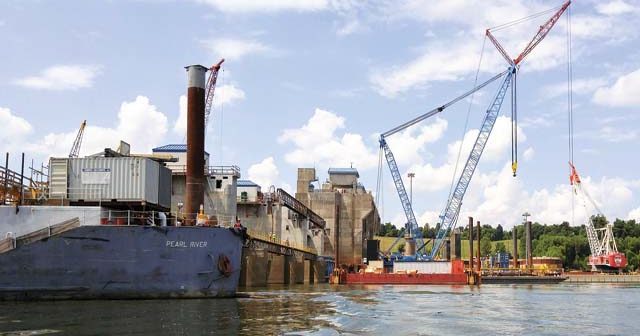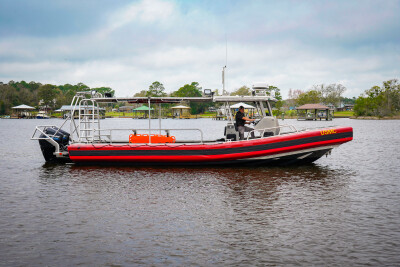President Trump’s fiscal year 2021 budget for the U.S. Army Corps of Engineers repeats a familiar playbook used by both his and previous administrations to impose deep spending cuts for the agency that oversees the inland waterways system and new fees on the navigation industry that Congress has continually rejected.
The budget proposal that was sent by the White House to Congress on Monday envisions a 22% reduction to the Corps’ civil works budget, from the current enacted level of $7.7 billion to $5.966 billion.
But in a departure from previous requests, the blueprint provides no money for construction of ongoing priority navigation projects that are cost-shared through the Inland Waterways Trust Fund (IWTF), to which the barge industry supports with a 29-cent-per gallon fuel tax. Waterways advocates called this unprecedented and astonishing, especially since Congress last year had approved $335 million to fund four priority projects.
At a press briefing held at the Corps headquarters in Washington, agency officials put a positive light on the proposal, saying it is more than $1 billion more than the administration’s FY2020 budget request of $4.9 billion. R.D. James, assistant secretary of the Army for Civil Works, called it “continuing advancement,” and said the proposal “reflects the realities of the nation’s fiscal status.”
He underscored that the budget emphasizes funding ongoing projects to completion, rather than starting new ones, and supporting those waterways and ports that manage the highest commercial traffic and bring in the most product and tonnage.
Specifically, the budget proposes $2.39 billion for commercial navigation and would establish an annual user fee to pay for future inland waterways investments and economic growth “by helping finance the users’ share of future capital investments,” according to the document. It states that 10% of revenue from this fee would go toward operation and maintenance costs of the inland system, which is traditionally a fully federal responsibility.
Trump and previous administrations have proposed user fees and budget cuts, but these have been rejected by Congress. For each of the past several years, lawmakers have actually approved Corps budgets that have hit historic highs.
The Trump proposal includes funds for Boston Harbor, Columbia River at the Mouth, OR and WA, Jacksonville Harbor deepening and the Mississippi River Ship Channel from the Gulf to Baton Rouge, Savannah Harbor expansion, Corpus Christi ship channel, replacement of the Sault Sainte Marie lock and the deepening of Jacksonville Harbor. None of these projects are funded through the Inland Waterways Trust Fund, however.
Waterways advocates cited inconsistencies and misplaced enthusiasm for the budget numbers and expressed shock at the lack of support for ongoing projects financed through the IWTF. In a statement yesterday, the Waterways Council, a Washington-based and industry-supported advocacy group, called the budget “astonishingly inadequate.”
“The 22 percent cut from what was appropriated by Congress is an increase over what the administration proposed last year and that is all today’s presenters wanted to acknowledge. It is as if Congress provided no additional funding and the budget is all about what the administration has to offer year to year,” Mike Toohey, president and CEO, told WorkBoat after attending the budget briefing.
He said that if the administration budget prevails, current construction work at the Kentucky Lock (Illinois/Kentucky) and the Chickamauga Lock (Tennessee) would end and workers would be dismissed. Toohey said the proposal would also shutter for one fiscal year construction projects at Olmsted lock and dam (for completion) and the Lower Mon project on the Mongahela River in Pennsylvania.
“While the president’s FY21 budget represents the administration’s priorities, WCI is extremely disappointed and absolutely astonished at no investment in rebuilding the nation’s critical inland waterways transportation system. No president has ever proposed zero infrastructure investment,” Toohey said in a statement. “Are we to lay off workers constructing the projects now underway? Where is the 29-cent-per-galling fuel tax money that users pay going while the administration seeks $180 million in additional annual fees with no plants to spend it? Where is the shame?”
Toohey also said that user fees would weigh heavily on the barge industry that already pay the fuel tax, and also hurt shippers and consumers. He said $1.8 million more in user fees over 10 years would amount to $180 million more per year in fees. “This, when the administration won’t even use the $120 million in revenue,” available in the Inland Waterways Trust Fund for inland construction projects.
He said the budget “will hopefully be considered dead on arrival in Congress, and I will offer to members of the House and Senate to provide the shovel and the preacher.”
Ports object to cuts
America’s seaports decried proposed elimination of two grant programs that benefit ports: the Port Intermodal Infrastructure Program, which last year awarded $500 million in grants to improve safety and efficiency of multimodal movements at ports, and the Port Security Grant program. They also objected to a nearly 90% reduction proposed in the EPA’s Diesel Emissions Reduction Act grants, which have helped reduce port-related diesel emissions.
Corps selects lock and dam and harbor deepening projects for 2020 funds
A few hours after the FY2021 budget rollout, the Corps released a Work Plan for spending $7.65 billion in FY 2020 funds for its civil works program. Among the construction projects that will be funded for completion this year are Locks and Dams 2,3 and 4 along the Monongahela River, PA, and the Olmsted Locks and Dam along the Ohio River in Illinois and Kentucky. The plan also includes funds to deepen Mobile Harbor, Ala. and the Mississippi River Ship Channel from Baton Rouge, La., to the Gulf, from 45 feet to 50 feet, allowing larger ships to be used. The channel accounts for 60% of U.S. soybean exports, along with 59% of corn exports, according to the Soy Transportation Coalition.
The Corps spending that was released last night also includes continued funding for two other projects: The Kentucky Lock in Kentucky and the Chicamauga Lock in Tennessee, as well as $4.5 million for the Navigation and Ecosystem Sustainability Program (NESP) on the Upper Mississippi River and Illinois Waterways.





